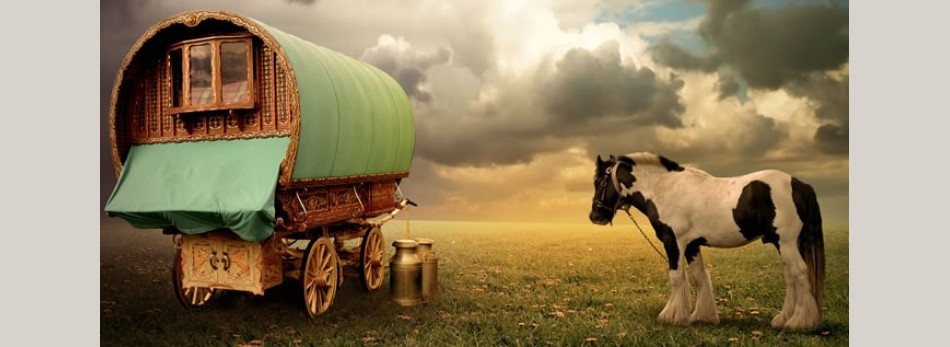Romani

Romani (Řomani ćhib) refers to is a group of languages that spoken by the Romani people. These languages belong to the Indo-Aryan branch of the Indo-European language family and are the only Indo-Aryan languages spoken exclusively outside the Indian subcontinent. Romani should not be confused with either Romanian, or Romansh, both of which are Romance languages. The ancestor of Romani is thought to have been the language of the Roma people of central India. Linguistic data suggest that the Roma left the Indian subcontinent in the second half of the first millennium AD, passing through what is now Afghanistan, Iran, Armenia, and Turkey. The cause of the Roma emigration is unknown due to the absence of written records. What is known is that they reached the Balkan peninsula by the 14th century AD. Some Roma migrated south to North Africa and reached Europe through the Strait of Gibraltar.
The development of Romani was strongly influenced by its contact with European languages. The greatest influence came from Byzantine Greek which had an impact on Romani vocabulary, phonology and grammar.
The Roma are popularly known in English as Gypsies, a word which is derived from the word Egypt, based on the mistaken belief that they were natives of Egypt. The term was never used by the Roma to describe themselves. In Europe, Gypsies are also known as Tsiganes, Zigeuners, and Gitanos.
In the absence of reliable census figures, the total population of Romani speakers can only be estimated. The largest numbers of Roma are found in the Balkans, Central Europe, U.S., Russia, and in the other former Soviet republics. Smaller numbers are scattered throughout Western Europe, the Middle East, and North Africa. Ethnologue classifies them into the following major groups.
-
U.S.
There is no census data on the number of Gypsies in the U.S. By most estimates, theremay be anywhere from 200,000 to 500,000 members of various Gypsy groups scattered around the country. They tend to live in poor urban areas and often try to conceal their ethnic identify to avoid discrimination. -
Europe
During the Holocaust,Gypsies, like the Jews, were targeted by the Nazis for persecution and annihilation. Today, however, Romani is the largest minority language in the European Union since it was joined by Romania and Bulgaria. In some European countries, Romani has limited use in government publications, education, and the media. Spain has a large number of Gypsies, called Gitanos. Most no longer speak Romani but a mixed language called Caló.
Dialects
There are several reasons for the great diversity of regional Romani dialects: (1) There is no standard language or prestige dialect of Romani to unify its diverse dialects; (2) Romani is influenced by a variety of local languages because it is spoken in many different countries and locations; (3) There is no single community of Romani speakers, and the speakers are not all in contact with each other. The Manchester Romani Project has created an interactive database and maps of Romani dialects.
There is a widely-accepted division between the Vlax (from Vlach) and non-Vlax dialects. Vlachs are Roma who have lived for many centuries in Romania. The main characteristic of Vlax is a large number of lexical borrowings from Romanian. Vlax-speaking groups include the greatest number of speakers of Romani. Some Roma speak mixed languages such as Caló in Spain, Lomavren in Armenia, and Angloromani in the U.K.
Structure
The sound inventory of Romani is similar to that of other Indo-Aryan languages. However, due to numerous borrowings from contact languages, the sound systems of different Romani dialects include additional phonemes from these languages.
Vowels
The vowel system of Romani typically consists of the five vowel phonemes. In addition, Western European dialects of Romanii tend to show vowel length distinctions.
|
Front
|
Central
|
Back
|
|
|---|---|---|---|
| Close |
i
|
u
|
|
| Mid |
e
|
o
|
|
| Open |
a
|
Consonants
Like other Indo-Aryan languages, Romani has a large number of consonants. However, it lacks voiced aspirated stops and affricates as well as retroflex consonants that are typical of the other Indo-Aryan languages. Some dialects of Romani in Eastern Europe distinguish between non-palatalized and palatalized consonants under the influence of Slavic languages in which palatalization is common.
|
Bilabial
|
Labio-dental
|
Alveo-
dental |
Postalveolar/
palatal |
Velar
|
Glottal
|
||
|---|---|---|---|---|---|---|---|
| Stops | unaspirated voiceless |
t
|
|||||
| aspirated voiceless |
pʰ
|
tʰ
|
kʰ
|
||||
| unaspirated voiced | b | d | g | ||||
| Fricatives | voiceless | f |
s
|
h | |||
| voiced | v | ʒ | |||||
| Affricates | unaspirated voiceless |
tʃ
|
|||||
| aspirated voiceless |
tʃʰ
|
||||||
| voiced |
dʒ
|
||||||
| Nasals | m | n | |||||
| Laterals | l | ||||||
| Rhotics | flap |
ɾ
|
|||||
| trill | |||||||
| Approximant |
w
|
- There is a contrast between aspirated vs. unaspirated voiceless stops and affricates, for instance, p – pʰ, t – tʰ, k – kʰ, tʃ – tʃʰ. Aspirated consonants are produced with a strong puff of air.
- /x/ = German pronunciation of ch in Bach
- /tʃ/ = ch in chop
- /dʒ/ = j in job
- /j/ = y in yet
Stress
Stress generally falls on the final inflectional suffix of Romani words, but its position may differ from variety to variety.
Romani is among the most conservative of Indo-Aryan languages. It has retained a number of grammatical features of nouns and verbs that have since disappeared in most other Indo-Aryan languages. Other languages have exerted a strong influence on Romani structure. For instance, Greek had a strong impact on the syntax of Romani, causing the emergence of a preposed definite article, and a shift from Subject-Object-Verb word order typical of Indo-Aryan languages to Subject-Verb-Object word order that is typical of European languages.
Nouns and adjectives
Romani noun morphology is inflectional, with some elements of agglutination. Romani noun declensions are thought to have survived in Eastern Europe due to the influence of Slavic languages, with the result that Romani has up to eight cases. In Western Europe, on the other hand, the tendency was for declensions to disappear in favor of the use of prepositions, some of them borrowed from European languages, e.g., mit ‘with’ (borrowed from German).
Romani nouns are marked for the following categories:
- There are two genders: masculine and feminine.
- There are two numbers: singular and plural.
- There are up to eight cases: nominative, accusative, dative, genitive, ablative, locative, instrumental, and vocative.
- Romani declensional classes are determined by gender and by the shape of the stem.
- There is a definite article that agrees with the noun in gender, number, and case.
- Adjectives agree with the nouns they modify in gender, number and case.
Verbs
Romani verbs have the following grammatical categories:
- person: lst, 2nd, 3rd
- number: singular and plural
- tense: present, past, future;
- aspect: imperfective and perfective
- mood: indicative, imperative, subjunctive, conditional
- conjugations: present and perfective
Word order
Word order in Romani differs from that in other Indo-Aryan languages due to the influence of Byzantine Greek with which the Roma had come in contact. The normal word order in Romani sentences is Subject-Verb-Object. Modifiers and the definite article precede the nouns they modify.
The basic vocabulary of Romani contains words found in other Indo-Aryan languages. When the nomadic ancestors of the Roma left their homeland and started their long journey westward more than a thousand years ago, they often stayed for long periods in places where they came in close contact with people who spoke different languages. The Roma borrowed words and even grammatical constructions from these languages. For instance, words of Persian and Greek origin can be found in all Romani varieties.
Below are some examples of common Romani words and phrases.
| Hello | Sastibe |
| Good bye | Dja devlesa |
| Thank you | Palikerav tut |
| Man | Manuš |
| Woman | Monašej |
| Yes | Va |
| No | Na |
Below are Romani numerals 1-10.
|
1
|
2
|
3
|
4
|
5
|
6
|
7
|
8
|
9
|
10
|
|---|---|---|---|---|---|---|---|---|---|
|
jekh
|
duj
|
trin
|
štar
|
pandž
|
šov
|
efta
|
oxto
|
ejnja
|
deš
|
Writing
Romani has traditionally been mostly an oral language, but In recent years, there has been a growing tendency to codify and standardize its different varieties. Below is an alphabet for Romani that was standardized in 1990 at the Fourth World Romani Congress in Poland. This alphabet is used today by most Romani communities.
|
A a
|
Ä ä
|
B b
|
C c
|
Ć ć
|
Č č
|
D d
|
E e
|
Ê ê
|
F f
|
G g
|
Ğ ğ
|
H h
|
I i
|
Î î
|
|
J j
|
K k
|
K k
|
L l
|
L l
|
M m
|
N n
|
N n
|
O o
|
Ö ö
|
P p
|
Ṗ ṗ
|
Q q
|
R r
|
R r
|
|
R r
|
S s
|
S s
|
S s
|
T t
|
T t
|
U u
|
U u
|
V v
|
W w
|
X x
|
Y y
|
Z z
|
Z z
|
Z z
|
Take a look at Article 1 of the Universal Declaration of Human Rights in Romani.
| Sa e manušikane strukture bijandžona tromane thaj jekhutne ko diniteti thaj capipa. Von si baxtarde em barvale gndaja thaj godžaja that trubun jerkh avereja te kherjakeren ko vodzi pralipaja. |
| All human beings are born free and equal in dignity and rights. They are endowed with reason and conscience and should act towards one another in a spirit of brotherhood. |
Romani is also written with an adapted Cyrillic alphabet in Russia and in the former Soviet republics..
|
А а
|
Б б
|
В в
|
Г г
|
|
Д д
|
Е е
|
Ё ё
|
Ж ж
|
З з
|
И и
|
Й й
|
К к
|
Кх кх
|
|
Л л
|
М м
|
Н н
|
О о
|
П п
|
Р р
|
С с
|
Т т
|
У у
|
Ф ф
|
Х х
|
Ц ц
|
Ч ч
|
Ш ш
|
|
Ы ы
|
Ь ь
|
Э э
|
Ю ю
|
Я я
|
Did You Know?
English slang contains several words of Romani origin. Among them are these common words:
| posh | likely from slang posh ‘dandy, from thieves’ slang meaning ‘money’, originally ‘coin of small value, halfpenny,’ possibly from Romaniposh ‘half” |
| pal | from English Romani pal ‘brother, comrade,’ variant of continental Romani pral, probably from Sanskrit bhrata ‘brother’ |
| dukes | possibly from Romani dook ‘the hand, as read in palmistry, one’s fate’ |
| shiv | from Romani word for ‘blade’ |







